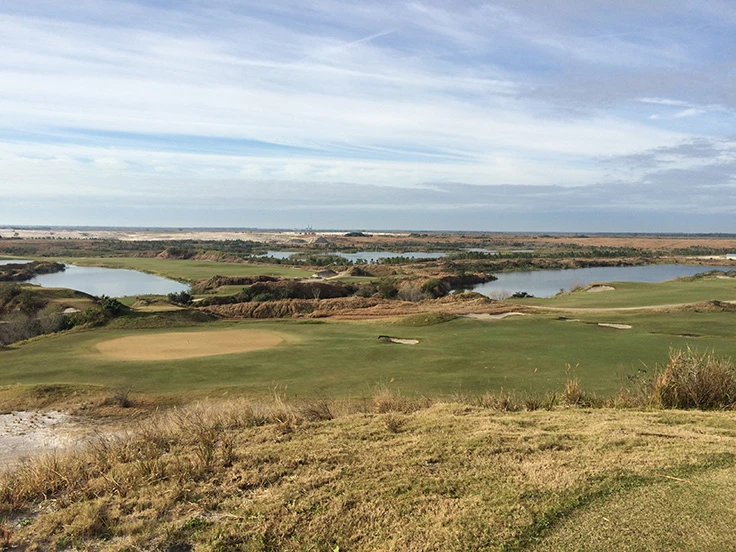
Streamsong Resort unveiled two 18-hole courses in 2012. A third course opens next year.
The central Florida resort’s golf expansion includes a noticeable absence inside its maintenance facility: an aerifier. Before calling director of agronomy Rusty Mercer zany or defiant, allow him to use a subject he relishes to explain his decision. Streamsong’s hole-free agronomics stem from science.
Mercer arrived at Streamsong in 2010, two years before the Tom Doak-designed Blue and Bill Coore/Ben Crenshaw-designed Red courses opened. His team has cultivated firm, fun playing conditions without punching a hole. In fact, the USGA thinks enough of Streamsong, which is managed by KemperSports, to bring this month’s U.S. Women’s Amateur Four-Ball to the Blue Course.
“We still have not aerified anything,” Mercer says. “Not once. The aerification is like the farmer that is constantly turning his fields over. When you do that, you expose all of that organic to UV light and all the other things, and you lose it. You don’t want to overcultivate. There is no need for us to aerify. We won’t change that until something changes in the profile.”
Streamsong’s soil profile is unlike any other in the United States. The resort rests on a former phosphate mine owned by Mosaic, a fertilizer company with massive land holdings in Florida. Executive Vice President and CFO Rich Mack calls reclaiming land the “lifeblood” of a company such as Mosaic. Despite a remote location in a golf-dense state – Streamsong is 48 miles from Tampa and 86 miles from Orlando – Mosaic took a risk by constructing the two courses in the middle of the 300,000 acres it owns in Florida. “When we were first doing this, people said ‘You guys are absolutely nuts because nobody is going to go out to the middle of nowhere,’” Mack says.
The quality of the land convinced Mosaic officials that golf had a chance of succeeding on the site. More than 10 million cubic yards of sand, including some that had formed 100-foot dunes, added to the site’s appeal.
Mercer, a three-decade superintendent who was working at The Golf Club at Cuscowilla, a Coore/Crenshaw-designed course in Eatonton, Ga., reached a juncture where he wanted to try something different. His future bosses heard demographic and economic reasons against building another golf course in Florida. Mercer heard agronomic reasons against leaving Georgia to grow Bermudagrass on top of a massive sand layer. Streamsong, though, offered a chance to build a soil profile from scratch while implementing principles passed down from soil gurus Dr. William Albrecht and Dick Psolla. “Soil biology is my passion,” Mercer says. “There’s not enough attention paid to it.”
Streamsong has experienced dramatic agronomic changes. The ground needed what Mercer calls “constant feeding, constant watering” in the courses’ early days. Inputs have been trimmed in half since the courses opened, according to Mercer. The fertility program consists of applying a quarter-pound of chicken manure monthly and .05 pounds of a soluble nitrogen source weekly. Mercer describes the irrigation program as being the “opposite of what we know to be good agronomic practices.” Heavy water dries the site faster than light and frequent irrigation. “It took me a while to figure out what’s happening,” he adds. “I tell my guys that if you stay here too long, you won’t be fit to go anywhere else because this is backwards.”
Beneath the turf, rests a 3 to 4 inches of what Mercer describes as a “true organic” layer. Mercer grabs organic material from the ground and sifts the fine texture in his hand to demonstrate a point to a visitor. Thatch is absent from the layer. Until proven otherwise, Mercer remains steadfast about Streamsong’s ability to provide quality turf without aerifying. “As long as the microbial populations continue to do what they are doing now, I don’t see a reason to aerify,” he says.
Lofty praise greeted Streamsong’s conditions since the courses’ inception, but Mercer says the Blue and Red are playing significantly better than when they opened.
“The greens initially were so hard that they didn’t hold anything,” he says. “Now a well-struck shot will hold. That’s a gray area. You want them to be firm. I grew bentgrass in the middle of Georgia for a lot of years and I hated that all summer because everything was just…” Mercer pauses and throws a ball into the ground behind a green. The impact causes a thumping sound. “These never get like that,” he adds. “But it’s a different plant. The ball will release on your chipping and pitching, but a well-struck 7 iron from 160 yards will hit, check, bounce twice and then come to rest. To me, that’s ideal.”
Guy Cipriano is GCI’s associate editor.
Latest from Golf Course Industry
- From the publisher’s pen: Conscientious of a bigger role
- Bernhard and Company partners with Laguna Golf Phuket
- Terre Blanche showcases environmental stewardship
- VIDEO: Introducing our December issue
- Bernhard and Company introduces Soil Scout
- Nu-Pipe donates to GCSAA Foundation’s Centennial Campaign
- GCSAA enhances golf course BMP tool
- Melrose leadership programs sending 18 to 2026 GCSAA Conference and Trade Show





